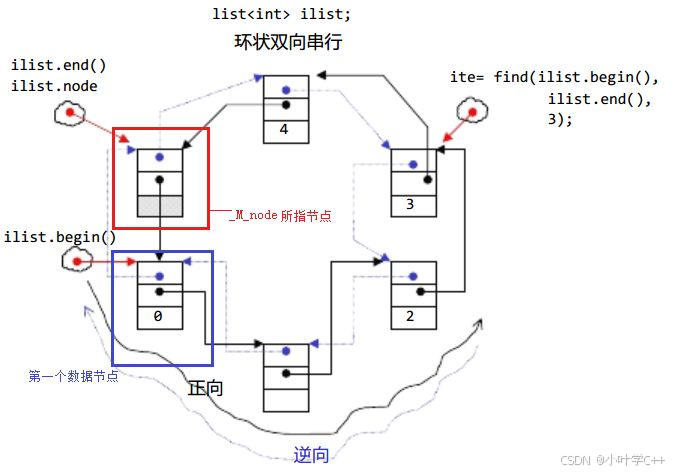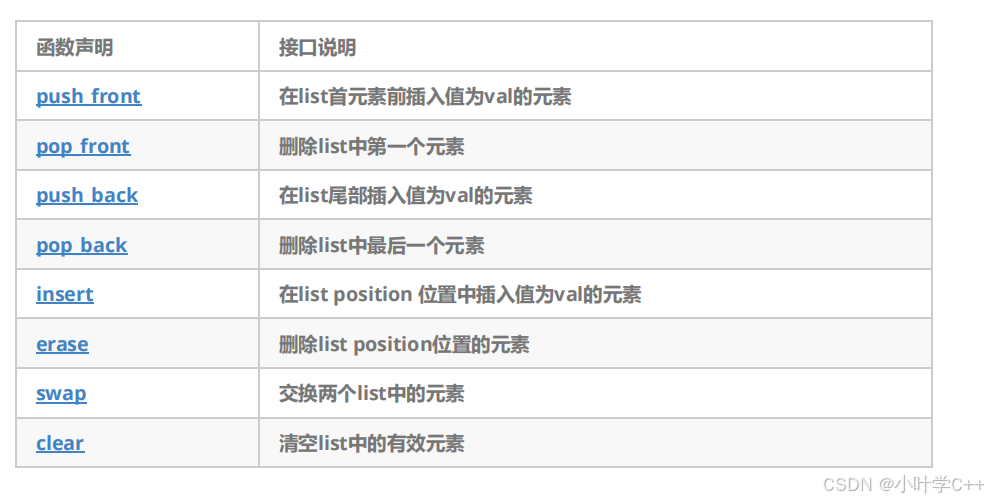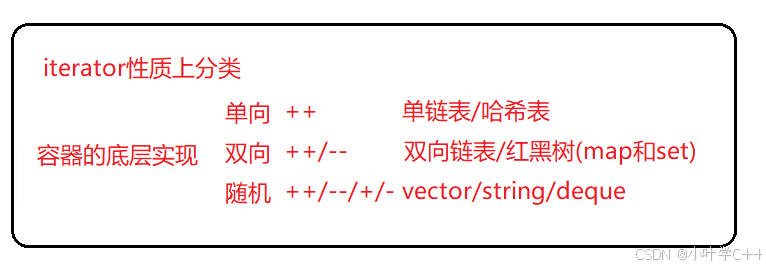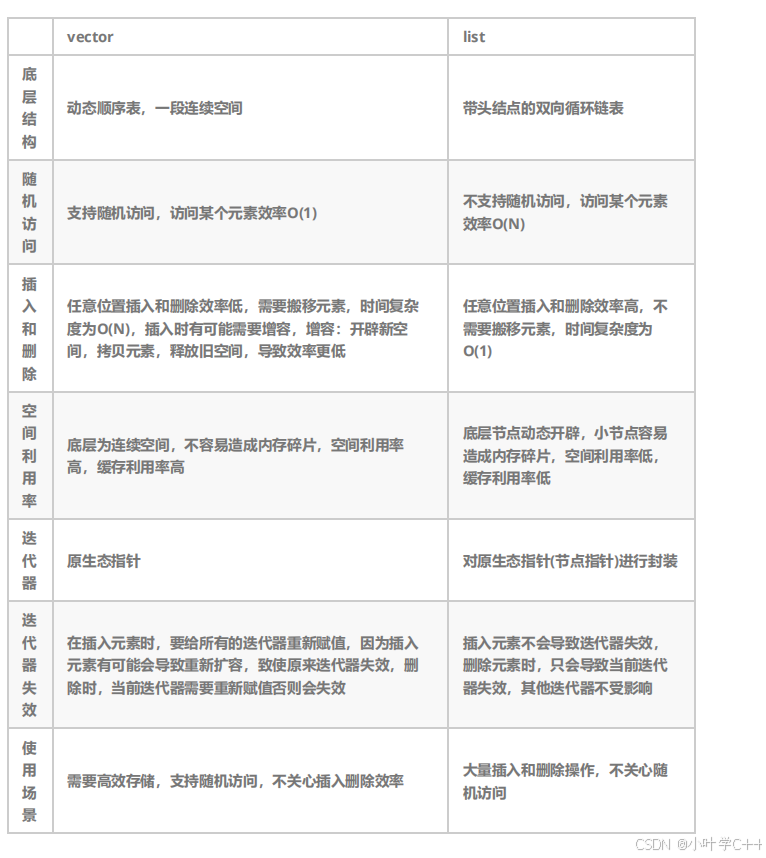1、list的介绍及使用
1.1 list的介绍
1.2 list的使用
1.2.1 list的构造
void TestList1()
{
list<int> l1; // 构造空的l1
list<int> l2(4, 100); // l2中包含4个值为100的元素
list<int> l3(l2.begin(), l2.end()); // 用l2的[begin(),end())构造l3
list<int> l4(l3); // 用l3拷贝构造l4
// 以数组为迭代器区间构造l5
int arr[] = { 16,2,77,29 };
list<int> l5(arr, arr + sizeof(arr) / sizeof(int));
// 列表格式初始化C++11
list<int> l6{ 1,2,3,4,5 };
list<int>::iterator it = l5.begin();
while (it != l5.end())
{
cout << *it << " ";
++it;
}
cout << endl;
for (auto& e : l6)
{
cout << e << " ";
}
cout << endl;
}1.2.2 list iterator的使用
// 注意:遍历链表只能用迭代器和范围for
void TestList2()
{
int arr[] = { 1,2,3,4,5,6,7,8,9,0 };
list<int> l(arr, arr + sizeof(arr) / sizeof(arr[0]));
// 使用正向迭代器遍历
list<int>::iterator it = l.begin();
while (it != l.end())
{
cout << *it << " ";
++it;
}
cout << endl;
// 使用反向迭代器遍历
list<int>::reverse_iterator rit = l.rbegin();
while (rit != l.rend())
{
cout << *rit << " ";
++rit;
}
cout << endl;
// 使用for循环遍历
// 注意这里调用的是list的begin() const,返回list的const_iterator对象
for (list<int>::const_iterator cit = l.begin(); cit != l.end(); ++cit)
{
cout << *cit << " ";
//*cit = 10; // 编译不通过
}
cout << endl;
}1.2.3 list capacity
1.2.4 list element access
1.2.5 list modifiers
void TestList3()
{
int arr[] = { 1,2,3 };
list<int> l(arr, arr + sizeof(arr) / sizeof(arr[0]));
// 在l的尾部插入4,头部插入0
l.push_back(4);
l.push_front(0);
for (auto& e : l)
{
cout << e << " ";
}
cout << endl;
// 获取链表第二个节点
auto pos = ++l.begin();
// 在pos位置之前插入7
l.insert(pos, 7);
// 用迭代器区间插入
vector<int> v{ 4,5,6 };
l.insert(pos, v.begin(), v.end());
for (auto& e : l)
{
cout << e << " ";
}
cout << endl;
// 删除pos位置上的元素
l.erase(pos);
for (auto& e : l)
{
cout << e << " ";
}
cout << endl;
}void TestList4()
{
int arr[] = { 1,2,3 };
list<int> l1(arr, arr + sizeof(arr) / sizeof(arr[0]));
// 交换l1和l2中的元素
list<int> l2;
l1.swap(l2);
for (auto& e : l1)
{
cout << e << " ";
}
cout << endl;
for (auto& e : l2)
{
cout << e << " ";
}
cout << endl;
// 清空l2中的元素
l2.clear();
cout << l2.size() << endl;
}1.2.6 list operations
void TestList5()
{
list<int> lt;
lt.push_back(1);
lt.push_back(2);
lt.push_back(3);
lt.push_back(4);
lt.push_back(5);
for (auto e : lt)
{
cout << e << " ";
}
cout << endl;
lt.reverse();
for (auto e : lt)
{
cout << e << " ";
}
cout << endl;
//sort(lt.begin(), lt.end()); // 报错,因为list底层是双向迭代器,而sort需要随机迭代器
// 升序 < less
//lt.sort();
// 降序 > greater
//greater<int> gt;
//lt.sort(gt);
lt.sort(greater<int>()); // 匿名对象
for (auto e : lt)
{
cout << e << " ";
}
cout << endl;
}void TestList6();
{
list<int> lt;
lt.push_back(1);
lt.push_back(2);
lt.push_back(3);
lt.push_back(4);
lt.push_back(3);
lt.push_back(3);
lt.push_back(3);
lt.push_back(5);
lt.push_back(5);
lt.push_back(3);
for (auto e : lt)
{
cout << e << " ";
}
cout << endl;
lt.sort(); // 先排序
lt.unique();// 再去重
for (auto e : lt)
{
cout << e << " ";
}
cout << endl;
lt.remove(3);
for (auto e : lt)
{
cout << e << " ";
}
cout << endl;
}1.2.7 list迭代器失效
此处大家可将迭代器暂时理解成类似于指针,迭代器失效即迭代器所指向的节点无效,即该节点被删除了。因为 list 的底层结构为带头结点的双向循环链表,因此在 list 中进行插入时是不会导致迭代器失效的,只有删除时才会失效,并且失效的只是指向被删除节点的迭代器,其他迭代器不会受到影响。
void TestListIterator1()
{
int arr[] = { 1, 2, 3, 4, 5, 6, 7, 8, 9, 0 };
list<int> l(arr, arr + sizeof(arr) / sizeof(arr[0]));
auto it = l.begin();
while (it != l.end())
{
// erase()函数执行后,it所指向的节点已被删除,因此it无效,在下一次使用it时,必须先给其赋值
l.erase(it);
++it;
}
}
// 改正
void TestListIterator()
{
int arr[] = { 1, 2, 3, 4, 5, 6, 7, 8, 9, 0 };
list<int> l(arr, arr + sizeof(arr) / sizeof(arr[0]));
auto it = l.begin();
while (it != l.end())
{
l.erase(it++); // it++作为参数传递给l.erase()
}
}2、list的模拟实现
2.1 模拟实现list
namespace yf
{
// list的节点类(模板类)
template<class T>
struct list_node
{
T _data;
list_node<T>* _next;
list_node<T>* _prev;
// T不一定是int,所以不能直接给0,要用匿名对象
list_node(const T& x = T())
:_data(x)
, _next(nullptr)
, _prev(nullptr)
{}
};
template<class T, class Ref, class Ptr>
struct __list_iterator
{
typedef list_node<T> Node;
typedef __list_iterator<T, Ref, Ptr> self;
Node* _node;
__list_iterator(Node* node)
:_node(node)
{}
// 前置++
self& operator++()
{
_node = _node->_next;
return *this;
}
// 前置--
self& operator--()
{
_node = _node->_prev;
return *this;
}
// 后置++
self operator++(int)
{
self tmp(*this);
_node = _node->_next;
return tmp;
}
// 后置--
self operator--(int)
{
self tmp(*this);
_node = _node->_prev;
return tmp;
}
Ref operator*()
{
return _node->_data;
}
Ptr operator->()
{
return &_node->_data;
}
// 用于比较两个迭代器是否相等
bool operator!=(const self& s)
{
return _node != s._node; // !=运算符是内置的指针比较运算符
}
bool operator==(const self& s)
{
return _node == s._node;
}
};
template<class T>
class list
{
typedef list_node<T> Node;
public:
typedef __list_iterator<T, T&, T*> iterator;
typedef __list_iterator<T, const T&, const T*> const_iterator;
const_iterator begin() const
{
// 这里跳到迭代器的构造函数创建了一个新的const_iterator对象,
// 使其指向_head->_next节点
return const_iterator(_head->_next);
}
const_iterator end() const
{
return const_iterator(_head);
}
iterator begin()
{
//return iterator(_head->_next);
return _head->_next; // list_node<T>*会被隐式类型转换为iteator对象
}
iterator end()
{
//return iterator(_head);
return _head;
}
// 空初始化
void empty_init()
{
_head = new Node;
_head->_next = _head;
_head->_prev = _head;
_size = 0;
}
// 无参构造函数
list()
{
empty_init();
}
// lt2(lt1)
list(const list<T>& lt)
{
// 先构造一个空的lt2
empty_init();
for (auto e : lt)
{
push_back(e);
}
}
void swap(list<int>& lt)
{
std::swap(_head, lt._head);
std::swap(_size, lt._size);
}
// lt3 = lt2
list<int>& operator=(list<int> lt)
{
swap(lt);
return *this;
}
~list()
{
clear();
delete _head;
}
void clear()
{
iterator it = begin();
while (it != end())
{
it = erase(it);
}
}
void push_back(const T& x)
{
insert(end(), x);
}
void pop_front()
{
erase(begin());
}
void pop_back()
{
erase(--end());
}
// 在pos位置之前插入,返回新插入的位置
iterator insert(iterator pos, const T& x)
{
Node* cur = pos._node;
Node* newnode = new Node(x);
Node* prev = cur->_prev;
prev->_next = newnode;
newnode->_prev = prev;
newnode->_next = cur;
cur->_prev = newnode;
++_size;
return iterator(newnode);
}
// 删除pos节点,返回pos节点的下一个节点的迭代器
iterator erase(iterator pos)
{
Node* cur = pos._node;
Node* prev = cur->_prev;
Node* next = cur->_next;
delete cur;
prev->_next = next;
next->_prev = prev;
--_size;
return iterator(next);
}
size_t size()
{
return _size;
}
private:
Node* _head;
size_t _size;
};
void test_list1()
{
list<int> lt;
lt.push_back(1);
lt.push_back(2);
lt.push_back(3);
lt.push_back(4);
lt.push_back(5);
// 封装
list<int>::iterator it = lt.begin();
while (it != lt.end())
{
*it += 20;
cout << *it << " ";
++it;
}
cout << endl;
for (auto e : lt)
{
cout << e << " ";
}
cout << endl;
}
void test_list2()
{
list<int> lt;
lt.push_back(1);
lt.push_back(2);
lt.push_back(3);
lt.push_back(4);
lt.push_back(5);
list<int> lt1(lt);
for (auto e : lt1)
{
cout << e << " ";
}
cout << endl;
list<int> lt2;
lt2.push_back(10);
lt2.push_back(20);
lt2.push_back(30);
lt2.push_back(40);
lt2.push_back(50);
lt1 = lt2;
for (auto e : lt1)
{
cout << e << " ";
}
cout << endl;
}
struct AA
{
AA(int a1 = 0, int a2 = 0)
:_a1(a1)
, _a2(a2)
{}
int _a1;
int _a2;
};
void test_list3()
{
list<AA> lt;
lt.push_back(AA(1, 1));
lt.push_back(AA(2, 2));
lt.push_back(AA(3, 3));
list<AA>::iterator it = lt.begin();
while (it != lt.end())
{
cout << it->_a1 << " " << it->_a2 << endl;
cout << it.operator->()->_a1 << " " << it.operator->()->_a2 << endl;
++it;
}
cout << endl;
}
//template<typename T>
//void print_list(const list<T>& lt)
//{
// // list<T>是未实例化的类模板,编译器不能去他里面找
// // 编译器无法判断list<T>::const_iterator是内嵌类型,还是静态成员变量
// // 前面加一个typename就是告诉编译器,这是一个类型,等list<T>实例化
// // 再去类里面找
// typename list<T>::const_iterator it = lt.begin();
// while (it != lt.end())
// {
// cout << *it << " ";
// ++it;
// }
// cout << endl;
//}
template<typename Container>
void print_container(const Container& con)
{
typename Container::const_iterator it = con.begin();
while (it != con.end())
{
cout << *it << " ";
++it;
}
cout << endl;
}
void test_list4()
{
list<int> lt;
lt.push_back(1);
lt.push_back(2);
lt.push_back(3);
lt.push_back(4);
lt.push_back(5);
print_container(lt);
vector<string> v;
v.push_back("11111111111");
v.push_back("11111111111");
v.push_back("11111111111");
v.push_back("11111111111");
print_container(v);
}
}









